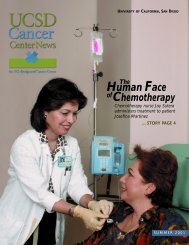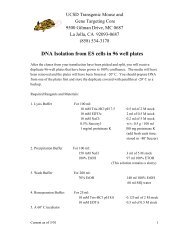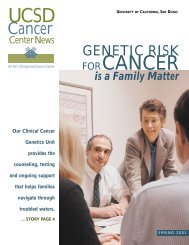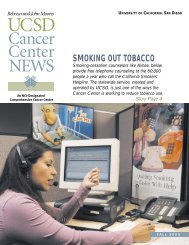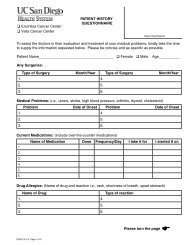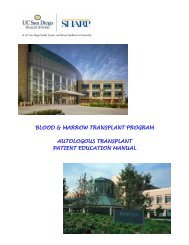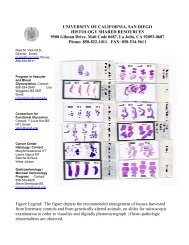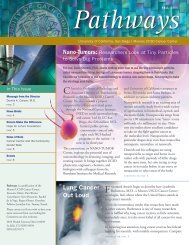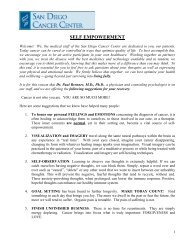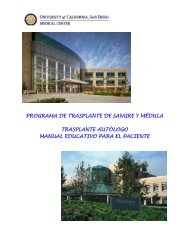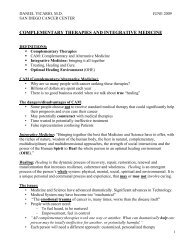The Science of Caring - Moores Cancer Center - UC San Diego
The Science of Caring - Moores Cancer Center - UC San Diego
The Science of Caring - Moores Cancer Center - UC San Diego
You also want an ePaper? Increase the reach of your titles
YUMPU automatically turns print PDFs into web optimized ePapers that Google loves.
PathwaysSpring 2007University <strong>of</strong> California, <strong>San</strong> <strong>Diego</strong> | Rebecca and John <strong>Moores</strong> <strong>UC</strong>SD <strong>Cancer</strong> <strong>Center</strong><strong>The</strong> <strong>Science</strong> <strong>of</strong> <strong>Caring</strong>For the Psychological, Spiritual, and Practical Needs <strong>of</strong> Patients<strong>The</strong> <strong>Moores</strong> <strong>UC</strong>SD <strong>Cancer</strong> <strong>Center</strong> is internationally recognized for its cutting-edge research, itsstate-<strong>of</strong>-the-art clinical services, and increasingly, its outstanding care <strong>of</strong> the psychological,spiritual, and practical needs <strong>of</strong> patients.In This IssueMessage from the DirectorDennis A. Carson, M.D.page 2What is a Clinical Trial?page 3News Briefspage 4Resources for Youpage 4Donors Make the DifferenceDiana Longpage 5Research Focuspage 5<strong>Cancer</strong> <strong>Center</strong> Eventspage 6Under the banner <strong>of</strong> “<strong>The</strong> <strong>Science</strong> <strong>of</strong><strong>Caring</strong>,” the <strong>Cancer</strong> <strong>Center</strong>’spsychosocial program aims to helppatients cope with the impact <strong>of</strong> cancer ontheir lives through family and individualcounseling, support groups, wellness andstress-reduction training, educationalseminars, and advocacy. Almost all <strong>of</strong> theseservices are available at no charge to patients,and their families, and to anyone in thecommunity.“Once someone walks through the doors <strong>of</strong>the <strong>Cancer</strong> <strong>Center</strong>, we want to be sure theynever feel alone,” says Matthew Loscalzo,MSW, Director <strong>of</strong> Patient and FamilySupport Services, who oversees the <strong>Science</strong> <strong>of</strong><strong>Caring</strong> Program. “We are committed topatients and their families and will be theconnective tissue between the <strong>Cancer</strong> <strong>Center</strong>and their normal life at home.”When Loscalzo arrived two-and-a-half yearsago, there was only one social worker for theentire <strong>Cancer</strong> <strong>Center</strong>—and that was nearlythe extent <strong>of</strong> support for patients.Today, the <strong>Science</strong> <strong>of</strong> <strong>Caring</strong> Program <strong>of</strong>fersunique services that set the <strong>Moores</strong> <strong>UC</strong>SD<strong>Cancer</strong> <strong>Center</strong> apart from almost all othercancer centers in the world: every newpatient is met by a social worker whoremains an integral part <strong>of</strong> their health careteam from diagnosis through treatment; allpatients complete a simple touch-screenquestionnaire at their first visit thatcommunicates immediate medical,psychological, and practical concerns to theirhealth care team; and, beginning in Spring2007, they will receive an orientation packetto help empower, inform, and guide themthrough their treatment.c o n t i n u e d on pa g e 2Pathways is a publication <strong>of</strong> the<strong>Moores</strong> <strong>UC</strong>SD <strong>Cancer</strong> <strong>Center</strong>.Executive Editor: Pam WernerContributors: Dora Dalton, JenniferHarris, Sarah Locher, Laura Margoni,Nancy Stringer, Tammy TraudtComments are welcome.3855 Health <strong>Science</strong>s Drive # 0658La Jolla, CA 92093-0658(858) 822-0175<strong>Moores</strong> <strong>UC</strong>SD <strong>Cancer</strong> <strong>Center</strong> PublishesCookbook and Nutrition GuideNutrition experts from the <strong>Moores</strong> <strong>UC</strong>SD <strong>Cancer</strong> <strong>Center</strong> havecreated a cookbook that is far more than just a compilation <strong>of</strong>healthy recipes. <strong>The</strong> book’s three co-authors, all members <strong>of</strong> the<strong>Cancer</strong> <strong>Center</strong>’s <strong>Cancer</strong> Prevention and Control Program, haveexpanded the cookbook concept to include helpful, easy-toreadinformational guidelines about healthy eating and living.“Food for Thought: Healing Foods to Savor” is a guide onnutritious foods and how to easily incorporate them intodaily meals. <strong>The</strong> book is based upon research conducted atthe <strong>Cancer</strong> <strong>Center</strong> and other recognized institutions.c o n t i n u e d on pa g e 3
Message from the DirectorWith the New Year comes a number <strong>of</strong> excitingnew initiatives at the <strong>Moores</strong> <strong>UC</strong>SD <strong>Cancer</strong><strong>Center</strong> that I would like to share with you.We are launching a major new research effort incollaboration with <strong>UC</strong>SD’s Scripps Institution <strong>of</strong>Oceanography (SIO) to develop cancer drugs fromthe sea. <strong>The</strong> program also involves scientists fromthe <strong>UC</strong>SD Skaggs School <strong>of</strong> Pharmacy andPharmaceutical <strong>Science</strong>s and the <strong>UC</strong>SDDepartment <strong>of</strong> Chemistry and Biochemistry. SIOhas one <strong>of</strong> the world’s most diverse collections <strong>of</strong>chemicals isolated from marine organisms.We believethese complex chemicals will be useful in cancer because they have naturallydeveloped over time to protect the organisms — sponges, algae and other marineinvertebrates — from attack. From our initial screening, we have already identifiedtwo extremely potent compounds that hold promise for anti-cancer drug development.Our unwavering focus oncuring and controlling cancerbrings new options and newhope to cancer patients.On the clinical side, we are expanding ourRadiation Oncology Department with a newfocus on technology development in order tobring the newest and best treatment optionsto patients. For example, we are currentlyone <strong>of</strong> only two centers in the nation <strong>of</strong>fering‘frameless’ radiosurgery for brain tumors. This is a non-invasive brain tumortreatment that is delivered in a single day without the use <strong>of</strong> surgical incisions, andwithout immobilization devices bolted to the skull.Soon, we will have a new director <strong>of</strong> the Division <strong>of</strong> Surgical Oncology. Thisdivision is being developed in collaboration with the <strong>UC</strong>SD Department <strong>of</strong>Surgery. <strong>The</strong> division will involve highly skilled surgeons who specialize onlyin cancer to ensure that our patients who need surgery are receiving care fromsomeone who is experienced in their disease and who is using the latest technology.As one <strong>of</strong> only a handful <strong>of</strong> federally designated comprehensive cancer centers inthe U.S., we play an important role in the national cancer effort. Our unwaveringfocus on curing and controlling cancer drives us to continually push out theboundaries <strong>of</strong> what is known, and to bring new options and new hope to cancerpatients. We believe this is why we have experienced an increase <strong>of</strong> 30 percentin patient visits in less than two years. Patients know that when they are facinga challenge like cancer, they can do no better than to come to a comprehensivecancer center like ours.Sincerely,<strong>The</strong> <strong>Science</strong> <strong>of</strong> <strong>Caring</strong>c o n t i n u e d from front co v e rOther <strong>Science</strong> <strong>of</strong> <strong>Caring</strong> resources includean innovative palliative care program andan active Patient Advisory Council. Inaddition, Loscalzo’s team continuallyevaluates all <strong>of</strong> the program’s services tohelp develop new knowledge that willenhance patient care—thus putting the“science” in the <strong>Science</strong> <strong>of</strong> <strong>Caring</strong>.At the <strong>Moores</strong> <strong>UC</strong>SD <strong>Cancer</strong> <strong>Center</strong>,hundreds <strong>of</strong> patients have welcomed andpraised these new services. One suchpatient, Lou <strong>San</strong>giolo, has participated inseveral supportive programs since hiscancer was diagnosed a year ago. He iscurrently undergoing chemotherapy, yet hestays active and finds encouragement frommany <strong>of</strong> the program’s sources.<strong>The</strong> <strong>Science</strong> <strong>of</strong> <strong>Caring</strong> team<strong>San</strong>giolo has been a regular at a weeklyPatient Support Group, has kept in closetouch with his social worker, and hasoccasionally sought additional help fromcounselors to cope with his cancer.“I’m a little bit calmer, a little bit smarter,and more patient. Counseling and supportgroups have improved my quality <strong>of</strong> lifeand my relationships,” he says.Dennis A. Carson, M.D.Director, <strong>Moores</strong> <strong>UC</strong>SD <strong>Cancer</strong> <strong>Center</strong>Chugai Pharmaceutical Chair in <strong>Cancer</strong>Associate Dean, <strong>UC</strong>SD Health <strong>Science</strong>s2
<strong>San</strong>giolo also has been a volunteer in thePatient and Family Education <strong>Center</strong>,which the <strong>Science</strong> <strong>of</strong> <strong>Caring</strong> Programcreated to serve as a reliable source <strong>of</strong>information about cancer. “I really washappy to talk to patients and share myexperiences,” he says. “And I got to talk tocaregivers and let them know that they,too, could get help.”<strong>San</strong>giolo’s advice to others who are facingcancer? “Use the services that are available.Just look at the <strong>Cancer</strong> <strong>Center</strong>’s Calendar<strong>of</strong> Activities—there are so many thingsavailable to help you.”<strong>The</strong>re’s much more that the <strong>Science</strong> <strong>of</strong><strong>Caring</strong> team hopes to implement in thenear future, including: navigationterminals to assist patients and visitors; acommunity wellness center; emergencyfunding to help cover patients’ practicalneeds such as legal services andtransportation to appointments; programsto engage and acknowledge <strong>Cancer</strong> <strong>Center</strong>staff; and broader programs for cancersurvivors.<strong>The</strong> most important message that the<strong>Science</strong> <strong>of</strong> <strong>Caring</strong> Program wants toimpart to patients and their loved ones:“We are here to help.”“It is our job to be certain that wemaximize normalcy in every waypossible—and our team knows how to dothat,” says Loscalzo.For more information on the <strong>Science</strong> <strong>of</strong> <strong>Caring</strong>Program, please call: (858) 822-3267 or Social WorkServices: (858) 822-2168 or email swhelps@ucsd.eduFood for Thoughtc o n t i n u e d from front co v e r“We included lots <strong>of</strong> tasty and easy recipes,”says co-author Susan Faerber, projectdirector <strong>of</strong> the Women’s Healthy Eating andLiving (WHEL) Study, the source for most<strong>of</strong> the information in the book. “<strong>The</strong>se arerecipes for real people; busy people whodon’t have a lot <strong>of</strong> time but who want tomake healthy meals and snacks for theirfamilies,” adds co-author Sheila Kealy, M.P.H.<strong>The</strong> book contains healthy eating andliving guidelines; a guide to understandingprotein, fat, carbohydrates, fiber, sodium,potassium, and calcium; an alphabeticalreference <strong>of</strong> vegetables, fruits, beans/legumes, and whole grains that includestips on how to select, store, and preparethem; and recipes with complete nutritionalanalyses.What is a Clinical Trial?clinical trial is a study conducted withA cancer patients, usually to evaluate anew treatment. Each study is designed toanswer scientific questions and to find newand better ways to help patients. People takepart in clinical trials for many reasons. <strong>The</strong>ymay hope for a cure, a longer time to live,or a way to feel better. Often they want tocontribute to a research effort that may helpothers, including family members. For example,when a woman with breast cancer participatesin a trial, her daughters, sisters, nieces,and granddaughters–who may be at risk <strong>of</strong>developing the disease in the future–standto benefit directly from the new knowledgegained from her participation in the trial.For example, the authors clear up theconfusion about carbohydrates — are theygood or bad? <strong>The</strong>y explain the benefits <strong>of</strong>fiber and provide best bets for fiber-rich foodsincluding broccoli, oranges, raspberries, andbarley. <strong>The</strong>y share secrets <strong>of</strong> how to easilysupercharge meals, and they provide tipson how to cut time and energy out <strong>of</strong> mealpreparation.“One <strong>of</strong> the biggest health concerns today iscancer, which will affect one <strong>of</strong> every two orthree people at some point in their lifetime,”says co-author Vicky A. Newman, M.S.,R.D., Associate Clinical Pr<strong>of</strong>essor <strong>of</strong> Familyand Preventive Medicine, <strong>UC</strong>SD School<strong>of</strong> Medicine. “Our research at the <strong>Moores</strong><strong>UC</strong>SD <strong>Cancer</strong> <strong>Center</strong> is contributing to theunderstanding <strong>of</strong> how diet can help preventand control diseases like cancer. We wanted toshare this important information, along withsimple ways for people to enjoy a variety <strong>of</strong>great foods <strong>of</strong>ten. This book does that in anupbeat and entertaining way.”“Food for Thought: Healing Foods to Savor”is available for $20 at the <strong>UC</strong>SD ThorntonHospital gift shop, <strong>UC</strong>SD Bookstore,or directly from the program’s Web site:www.healthyeating.ucsd.edu. All proceedsbenefit the <strong>Cancer</strong> Prevention and ControlProgram at the <strong>Moores</strong> <strong>UC</strong>SD <strong>Cancer</strong> <strong>Center</strong>.If you think you may be interested inparticipating in a clinical trial, or just wantfurther information, visit the <strong>Cancer</strong> <strong>Center</strong>’sWeb site at www.cancer.ucsd.edu or contactthe Clinical Trials Office at (858) 822-5354or email cancercto@ucsd.edu. Please alsoconsider visiting our Patient and FamilyEducation <strong>Center</strong> where trained volunteersare available to help with clinical trialsinformation.3
News Briefs<strong>Moores</strong> Partners with Light One Little Candle Foundation<strong>The</strong> <strong>Moores</strong> <strong>UC</strong>SD <strong>Cancer</strong> <strong>Center</strong>held a kick<strong>of</strong>f event on November15 for its new partnership with theLight One Little Candle Foundation(LOLC), a non-pr<strong>of</strong>it organization thatencourages parents undergoing cancertreatment to read to their children.<strong>The</strong> program distributes new children’sbooks to cancer patients through the<strong>Cancer</strong> <strong>Center</strong>’s Patient and FamilyEducation <strong>Center</strong>. Children’s classicsare available in both English and Spanish along with selections written in English butgeared towards other cultures. To make a donation or to purchase books for LOLC atthe <strong>Cancer</strong> <strong>Center</strong>, visit www.lightonelittlecandle.org.Links Found Between Sunlight Exposure and Ovarian & Kidney <strong>Cancer</strong>Using a newly available database <strong>of</strong> worldwide cancer incidence, researchers at the<strong>Moores</strong> <strong>UC</strong>SD <strong>Cancer</strong> <strong>Center</strong> have published two studies indicating a clear associationbetween deficiency in exposure to sunlight, specifically ultraviolet B (UVB), and bothkidney cancer and ovarian cancer. UVB exposure triggers photosynthesis <strong>of</strong> vitaminD3 in the body. This form <strong>of</strong> vitamin D is also available through diet and supplements.In both studies, researchers used a new tool called GLOBOCAN, developed by theWorld Health Organization’s International Agency for Research on <strong>Cancer</strong>, to mapcancer incidence rates for 175 countries. <strong>The</strong> plots resulted in parabolic curvesindicating high cancer rates at high latitudes and low cancer rates in the equatorialregion. Because there are many variables besides sun exposure associated with location,the researchers recommend further studies on the effects <strong>of</strong> vitamin D3 and cancer risk.Dr. Webster K. Cavenee Awarded Albert Szent-Györgyi Prize<strong>The</strong> National Foundation for <strong>Cancer</strong> Research (NFCR) awardedWebster K. Cavenee, Ph.D., the 2nd Annual Albert Szent-GyörgyiPrize for Progress in <strong>Cancer</strong> Research. <strong>The</strong> prize was established tohonor pioneering scientists who have made outstanding scientificachievements in the war against cancer. Dr. Cavenee is Director<strong>of</strong> the Ludwig Institute for <strong>Cancer</strong> Research (LICR) <strong>San</strong> <strong>Diego</strong>Branch, Pr<strong>of</strong>essor <strong>of</strong> Medicine and member <strong>of</strong> the <strong>Moores</strong> <strong>UC</strong>SD<strong>Cancer</strong> <strong>Center</strong>. His research provided the first genetic evidence forthe existence <strong>of</strong> tumor suppressor genes, one <strong>of</strong> the most influential breakthroughs incancer research.American <strong>Cancer</strong> Society Honors <strong>Moores</strong> <strong>Cancer</strong> <strong>Center</strong>, Appoints Sadler<strong>The</strong> <strong>San</strong> <strong>Diego</strong> <strong>of</strong>fice <strong>of</strong> the American <strong>Cancer</strong> Society (ACS) honored the <strong>Moores</strong> <strong>UC</strong>SD<strong>Cancer</strong> <strong>Center</strong> as “Healthcare Partner <strong>of</strong> the Year” for its participation and collaborationin a number <strong>of</strong> patient service and educational programs. <strong>The</strong> award was presentedDecember 6th at the ACS’s annual “Community Salute.” Georgia Robins Sadler, Ph.D.,has also been appointed as President-Elect <strong>of</strong> the board <strong>of</strong> directors for the CaliforniaDivision <strong>of</strong> the ACS, where she will provide strategic leadership for all the healthinitiatives <strong>of</strong> the California Division. Sadler is currently the Associate Director forCommunity Outreach at the <strong>Moores</strong> <strong>UC</strong>SD <strong>Cancer</strong> <strong>Center</strong>.4Resources for YouTips For Early Detection<strong>The</strong> following are steps you can take to findcancer early, when there is the best chance forcure. (Guidelines apply to average risk peoplewith no symptoms.)Breast <strong>Cancer</strong>Breast self-exam—Monthly starting at age 20Clinical breast exam—Every 3 years startingat age 20; annually starting at age 40Mammogram—Annually starting at age 40Cervical <strong>Cancer</strong>Pap smear and pelvic exam—Annuallystarting approximately age 21; every 2-3 yearsafter 3 consecutive normal results.Colorectal <strong>Cancer</strong>Fecal occult blood test—Annually starting atage 50Sigmoidoscopy—Every 5 years starting at age 50Colonoscopy—Every 10 years starting at age 50Prostate <strong>Cancer</strong>Digital rectal exam—Annually starting at age 50PSA test—Annually starting at age 50Oral <strong>Cancer</strong>sDuring your regular checkup, ask the dentistto check your mouth and gums.Family HistoryLearn about your family risk <strong>of</strong> cancer; 5 to10 percent <strong>of</strong> all cancers occur in people witha family member with the same cancer.Knowing what cancers have been in the familyis the first step toward tailored screening andpreventive options.EnvironmentAvoid exposure to environmental chemicalsknown to cause cancer such as radon andbenzene. Have your home tested for radon, anodorless gas released from rocks and soil thatenters homes through cracks in the foundation.Benzene is a natural part <strong>of</strong> gasoline andcigarette smoke; exposure comes frominhaling air that contains it, so avoid smoking,secondhand smoke, and vapors from heavytraffic and gas stations as much as possible.(radon—lung cancer; benzene—leukemia)Information sources: <strong>Cancer</strong> Prevention andControl Program <strong>of</strong> <strong>Moores</strong> <strong>UC</strong>SD <strong>Cancer</strong><strong>Center</strong>, and the National <strong>Cancer</strong> Institute.
Donors Make the DifferenceDr. Thomas Kipps with Diana LongAnd although most thyroid cancers arecurable, CLL is not. So while Long hadher thyroid removed and underwentiodine radiation therapy to treat herthyroid cancer, she found there was littleshe could do to fight such an aggressiveform <strong>of</strong> leukemia. Faced with a lifeexpectancy <strong>of</strong> three-to-eight years, Longbegan searching for researchers wh<strong>of</strong>ocused on CLL. She found Dr. ThomasKipps, the Deputy Director for Researchat the <strong>Moores</strong> <strong>UC</strong>SD <strong>Cancer</strong> <strong>Center</strong> andthe Founder and Director <strong>of</strong> the Blood<strong>Cancer</strong> Research Fund.“Dr. Kipps is brilliant,” says Long. “Heleads the effort to find a cure for CLLwhile treating patients like me withgenuine concern for our well being.” Sostrong is her trust in Kipps that althoughshe and her husband have since movedfrom <strong>San</strong> <strong>Diego</strong> to the Bay Area to beDiana LongFor most people, battling one type <strong>of</strong> cancerwould be enough <strong>of</strong> a challenge in life, but asDiana Long learned in 2002, she didn’t face justone challenge, she faced two: “I was diagnosedwith thyroid cancer and chronic lymphocyticleukemia (CLL) that year,” she recalls. “It wasquite a shock.”closer to family, she returns to <strong>San</strong> Dieg<strong>of</strong>or her main treatments.Her belief in his abilities also led her tobecome one <strong>of</strong> his strongest supporters.Not only did Long and her family pledge$50,000 toward Kipps’ research efforts,but she also sent out a fundraising letterto some 250 friends, family members,and acquaintances. Her efforts yieldednearly $65,000 in support, with giftsranging from $25 to $10,000.Since then, Long has continued herefforts to support cancer research and istrying to stay involved in any way she can.“Patients like me have the best chance <strong>of</strong>raising funds because people respond bestto the people they know,” she says. “Ithink we’re close to finding a cure and Iwant to help as much as possible. I’ll doeverything I can to help move theresearch forward.”Jump-start your legacyWith a New Tax-Saving Opportunity for IRA Owners…You may be interested in the recent changes made through the Pension Protection Act<strong>of</strong> 2006. Of special interest is the provision that allows tax-free distribution <strong>of</strong> up to$100,000 per year from Individual Retirement Accounts directly to qualified nonpr<strong>of</strong>itorganizations, including the <strong>UC</strong> <strong>San</strong> <strong>Diego</strong> Foundation. While no charitable incomededuction accompanies the transfer, the distribution directly to the charity is notincluded in taxable income. Gifts must be completed by December 31, 2007, and theowner <strong>of</strong> the IRA account must be age 70 or older by the date <strong>of</strong> the contribution.This is an excellent opportunity to give to the <strong>Moores</strong> <strong>UC</strong>SD <strong>Cancer</strong> <strong>Center</strong>! If you haveany questions or would like a free copy <strong>of</strong> our brochure, How To Make Charitable GiftsFrom Your IRA, please feel free to contact Ge<strong>of</strong>f Graham at (858) 534-2249 or visit ourWeb site at www.plannedgiving.ucsd.edu.Research FocusVassiliadis Fellow TargetsImportant Pathway in CLLResearch sometimes takes us to unexpectedplaces, and this is indeed the case for VassiliadisFellow Jerry Liu, M.D., Ph.D. Eighteen monthsago, Liu’s investigations concerning organbasedcancers led him to focus on the Wnt/b-catenin signaling pathway–a pathway thathas remarkable potential in treating chroniclymphocytic leukemia (CLL).CLL is the most common leukemia amongadults in the U.S. A cancer characterized by theoverproduction <strong>of</strong> mature lymphocytes (a type <strong>of</strong>white blood cell), this progressive disease is dueto an abnormal balance in the signals for cellsurvival and cell death which can leave the bodysusceptible to anemia, infection, and bleeding.Liu surmised that by targeting the pathway inthese cells, they would instead die as theynormally should. His next charge: to find aneffective pathway inhibitor.Liu and colleagues set out to screen a druglibrary <strong>of</strong> 960 commercially-available drugs,working in the <strong>Moores</strong> <strong>UC</strong>SD <strong>Cancer</strong> <strong>Center</strong>,in Director Dennis Carson’s lab. A commondiuretic drug used in the 1970s, ethacrynicacid (EA), was identified as a strong inhibitor <strong>of</strong>this pathway. Using a tissue culture system, Liushowed that EA was very potent in inducing celldeath in CLL cells and in concentrations thatcould be safely used in patients.He also found that EA had a synergistic effectwith fludarabine, which currently is the drugwith the highest rate <strong>of</strong> response in untreatedpatients with CLL. This is important becausesome patients become resistant to fludarabine;perhaps EA could reverse this resistance.Based on these findings, a clinical trial with EAin fludarabine refractory patients is currentlyunderway at the <strong>Moores</strong> <strong>Cancer</strong> <strong>Center</strong>. Patientseligible for this clinical trial must have advancedCLL and have failed chemotherapy treatments.Liu’s research was supported by the Carol andAlkiviadis Vassiliadis Endowed Fellowship, whichhe was awarded in June 2005. <strong>The</strong> Fellowship’s“seed money” allowed him to pursue cuttingedgeresearch, present findings at the 48thAnnual Society <strong>of</strong> Hematology annual meeting,and prepare results for publication.5
<strong>Moores</strong> <strong>Cancer</strong> <strong>Center</strong> EventsMarch 7Faculty Ambassador Event“Ovarian <strong>Cancer</strong>: What You Should Know”Speaker: Cheryl Saenz, M.D.<strong>Moores</strong> <strong>Cancer</strong> <strong>Center</strong>6:00 – 8:00 p.m.May 1226th Celebrity Chefs Cook Gala“Très Gourmet”Sheraton <strong>San</strong> <strong>Diego</strong> Hotel and Marina6:00 p.m. – MidnightJune 5Faculty Ambassador Event“Biomarkers and Personalized Medicine”Speaker: Richard Schwab, M.D.<strong>Moores</strong> <strong>Cancer</strong> <strong>Center</strong>6:00 – 8:00 p.m.August 19Luau & Longboard InvitationalScripps Pier7:00 a.m. – 1:00 p.m. Longboard Invitational9:00 a.m. Registration begins11:30 a.m. Luau opensSeptember 12Faculty Ambassador Event“Prostate <strong>Cancer</strong> and the Diet’s Role in Prevention”Speaker: Kelly Parsons, M.D.<strong>Moores</strong> <strong>Cancer</strong> <strong>Center</strong>6:00 – 8:00 p.m.October 135K Melanoma Walk for a Cure<strong>UC</strong>SD Campus, Faculty Club8:30 a.m.For reservations and information please call (858) 822-0175. For a complete event schedule,please visit our Web site at www.cancer.ucsd.edu.Helping YouGet Connected!<strong>The</strong> following phone numbersand Web site address areprovided here to help youquickly and easily access theinformation you need:General information(858) 534-7600New patients(858) 822-6100 ortoll-free (866) 773-2703Clinical trials(858) 822-5354If you are a physician(888) 822-8741Charitable donations(858) 822-0175Web sitewww.cancer.ucsd.edu<strong>Moores</strong> <strong>UC</strong>SD <strong>Cancer</strong> <strong>Center</strong>President <strong>of</strong> the BoardCarol Littlejohn Changboard <strong>of</strong> directorsJ. Samuel Armstrong, IVKathryn A. Bernert Morgan, Esq.Gordon P. BoernerMarilynn BoeskyHoward I. CohenL. Reneé ComeauWilliam T. Comer, Ph.D.Charles FaithDaniel J. GattoFrank M. GoldbergCharles F. Gorder, Sr., Esq.Donald W. GrimmMaurice C. Kaplan, Esq.Jerome S. Katzin, Esq.George L. Liggins, M.P.H., Ph.D.Jeffrey LipinskyCinda K. LucasJoany MosherAlex M. Nadzan, Ph.D.Henry L. Nordh<strong>of</strong>fAnne S. OttersonJohn W. Otterson, IIRudolph RehmMary Rand TaylorCarol Vassiliadisex <strong>of</strong>ficio membersMarye Anne Fox, Ph.D.Rebecca NewmanSuzanne AgarwalPaul GraysonSue KalishCraig Knoxadvisory boardLois CrandellAudrey GeiselGeorge L. GildredIrwin Jacobs, Ph.D.Richard LeviMarianne McDonald, Ph.D.Peter PreussRuth L. SchulmanWalter ZableDirector, <strong>Moores</strong> <strong>UC</strong>SD<strong>Cancer</strong> <strong>Center</strong>Dennis A. Carson, M.D.Medical Director,Deputy DirectorClinical OncologyJoanne Mortimer, M.D.Deputy Director,Research OperationsThomas J. Kipps, M.D., Ph.D.Associate Director,AdministrationIra S. GoodmanDirector <strong>of</strong> DevelopmentPamela M. Werner, CFREPathwaysspring 2007University <strong>of</strong> California, <strong>San</strong> <strong>Diego</strong> | Rebecca and John <strong>Moores</strong> <strong>UC</strong>SD <strong>Cancer</strong> <strong>Center</strong>Non-Pr<strong>of</strong>it Org.U.S. PostageP A I D3855 Health <strong>Science</strong>s Drive #0658<strong>San</strong> <strong>Diego</strong>, CALa Jolla, CA 92093-0658Permit No. 1909



